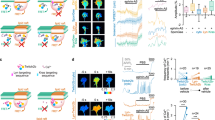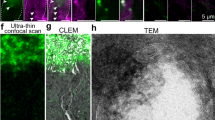Abstract
Asymmetric elevation of the Ca2+ concentration in the growth cone can mediate both attractive and repulsive axon guidance. Ca2+ signals that are accompanied by Ca2+-induced Ca2+ release (CICR) trigger attraction, whereas Ca2+ signals that are not accompanied by CICR trigger repulsion. The molecular machinery downstream of Ca2+ signals, however, remains largely unknown. Here we report that asymmetric membrane trafficking mediates growth cone attraction. Local photolysis of caged Ca2+, together with CICR, on one side of the growth cone of a chick dorsal root ganglion neuron facilitated the microtubule-dependent centrifugal transport of vesicles towards the leading edge and their subsequent vesicle-associated membrane-protein 2 (VAMP2)–mediated exocytosis on the side with an elevated Ca2+ concentration. In contrast, Ca2+ signals without CICR had no effect on the vesicle transport. Furthermore, pharmacological inhibition of VAMP2-mediated exocytosis prevented growth cone attraction, but not repulsion. These results strongly suggest that growth cone attraction and repulsion are driven by distinct mechanisms, rather than using the same molecular machinery with opposing polarities.
This is a preview of subscription content, access via your institution
Access options
Subscribe to this journal
Receive 12 print issues and online access
$209.00 per year
only $17.42 per issue
Buy this article
- Purchase on Springer Link
- Instant access to full article PDF
Prices may be subject to local taxes which are calculated during checkout








Similar content being viewed by others
Change history
04 January 2007
Videos were incorrectly switched
References
Tessier-Lavigne, M. & Goodman, C.S. The molecular biology of axon guidance. Science 274, 1123–1133 (1996).
Song, H.J. & Poo, M.M. Signal transduction underlying growth cone guidance by diffusible factors. Curr. Opin. Neurobiol. 9, 355–363 (1999).
Henley, J. & Poo, M.M. Guiding neuronal growth cones using Ca2+ signals. Trends Cell Biol. 14, 320–330 (2004).
Zheng, J.Q. Turning of nerve growth cones induced by localized increases in intracellular calcium ions. Nature 403, 89–93 (2000).
Gomez, T.M. & Zheng, J.Q. The molecular basis for calcium-dependent axon pathfinding. Nat. Rev. Neurosci. 7, 115–125 (2006).
Gomez, T.M., Robles, E., Poo, M.M. & Spitzer, N.C. Filopodial calcium transients promote substrate-dependent growth cone turning. Science 291, 1983–1987 (2001).
Henley, J.R., Huang, K.H., Wang, D. & Poo, M.M. Calcium mediates bidirectional growth cone turning induced by myelin-associated glycoprotein. Neuron 44, 909–916 (2004).
Hong, K., Nishiyama, M., Henley, J., Tessier-Lavigne, M. & Poo, M. Calcium signalling in the guidance of nerve growth by netrin-1. Nature 403, 93–98 (2000).
Ooashi, N., Futatsugi, A., Yoshihara, F., Mikoshiba, K. & Kamiguchi, H. Cell adhesion molecules regulate Ca2+-mediated steering of growth cones via cyclic AMP and ryanodine receptor type 3. J. Cell Biol. 170, 1159–1167 (2005).
Jin, M. et al. Ca2+-dependent regulation of rho GTPases triggers turning of nerve growth cones. J. Neurosci. 25, 2338–2347 (2005).
Lockerbie, R.O., Miller, V.E. & Pfenninger, K.H. Regulated plasmalemmal expansion in nerve growth cones. J. Cell Biol. 112, 1215–1227 (1991).
Craig, A.M., Wyborski, R.J. & Banker, G. Preferential addition of newly synthesized membrane protein at axonal growth cones. Nature 375, 592–594 (1995).
Igarashi, M. et al. Growth cone collapse and inhibition of neurite growth by Botulinum neurotoxin C1: a t-SNARE is involved in axonal growth. J. Cell Biol. 134, 205–215 (1996).
Kimura, K., Mizoguchi, A. & Ide, C. Regulation of growth cone extension by SNARE proteins. J. Histochem. Cytochem. 51, 429–433 (2003).
Diefenbach, T.J., Guthrie, P.B., Stier, H., Billups, B. & Kater, S.B. Membrane recycling in the neuronal growth cone revealed by FM1–43 labeling. J. Neurosci. 19, 9436–9444 (1999).
Kamiguchi, H. & Lemmon, V. Recycling of the cell adhesion molecule L1 in axonal growth cones. J. Neurosci. 20, 3676–3686 (2000).
Kamiguchi, H. & Yoshihara, F. The role of endocytic L1 trafficking in polarized adhesion and migration of nerve growth cones. J. Neurosci. 21, 9194–9203 (2001).
Zakharenko, S. & Popov, S. Dynamics of axonal microtubules regulate the topology of new membrane insertion into the growing neurites. J. Cell Biol. 143, 1077–1086 (1998).
Hirokawa, N. & Takemura, R. Molecular motors and mechanisms of directional transport in neurons. Nat. Rev. Neurosci. 6, 201–214 (2005).
Buck, K.B. & Zheng, J.Q. Growth cone turning induced by direct local modification of microtubule dynamics. J. Neurosci. 22, 9358–9367 (2002).
Dent, E.W. & Gertler, F.B. Cytoskeletal dynamics and transport in growth cone motility and axon guidance. Neuron 40, 209–227 (2003).
Chen, Y.A. & Scheller, R.H. SNARE-mediated membrane fusion. Nat. Rev. Mol. Cell Biol. 2, 98–106 (2001).
Sabo, S.L. & McAllister, A.K. Mobility and cycling of synaptic protein-containing vesicles in axonal growth cone filopodia. Nat. Neurosci. 6, 1264–1269 (2003).
Igarashi, M., Tagaya, M. & Komiya, Y. The soluble N-ethylmaleimide-sensitive factor attached protein receptor complex in growth cones: molecular aspects of the axon terminal development. J. Neurosci. 17, 1460–1470 (1997).
Nagai, T. et al. A variant of yellow fluorescent protein with fast and efficient maturation for cell-biological applications. Nat. Biotechnol. 20, 87–90 (2002).
Zheng, J.Q., Wan, J.J. & Poo, M.M. Essential role of filopodia in chemotropic turning of nerve growth cone induced by a glutamate gradient. J. Neurosci. 16, 1140–1149 (1996).
Yuan, X.B. et al. Signalling and crosstalk of Rho GTPases in mediating axon guidance. Nat. Cell Biol. 5, 38–45 (2003).
Leung, K.M. et al. Asymmetrical β-actin mRNA translation in growth cones mediates attractive turning to netrin-1. Nat. Neurosci. 9, 1247–1256 (2006).
Yao, J., Sasaki, Y., Wen, Z., Bassell, G.J. & Zheng, J.Q. An essential role for β-actin mRNA localization and translation in Ca2+-dependent growth cone guidance. Nat. Neurosci. 9, 1265–1273 (2006).
Lin, C.H. & Forscher, P. Growth cone advance is inversely proportional to retrograde F-actin flow. Neuron 14, 763–771 (1995).
Schaefer, A.W., Kabir, N. & Forscher, P. Filopodia and actin arcs guide the assembly and transport of two populations of microtubules with unique dynamic parameters in neuronal growth cones. J. Cell Biol. 158, 139–152 (2002).
Miesenbock, G., De Angelis, D.A. & Rothman, J.E. Visualizing secretion and synaptic transmission with pH-sensitive green fluorescent proteins. Nature 394, 192–195 (1998).
Campbell, R.E. et al. A monomeric red fluorescent protein. Proc. Natl. Acad. Sci. USA 99, 7877–7882 (2002).
Bridgman, P.C. Myosin-dependent transport in neurons. J. Neurobiol. 58, 164–174 (2004).
Osen-Sand, A. et al. Common and distinct fusion proteins in axonal growth and transmitter release. J. Comp. Neurol. 367, 222–234 (1996).
Martinez-Arca, S., Alberts, P., Zahraoui, A., Louvard, D. & Galli, T. Role of tetanus neurotoxin insensitive vesicle-associated membrane protein (TI-VAMP) in vesicular transport mediating neurite outgrowth. J. Cell Biol. 149, 889–900 (2000).
Ming, G. et al. Phospholipase C-gamma and phosphoinositide 3-kinase mediate cytoplasmic signaling in nerve growth cone guidance. Neuron 23, 139–148 (1999).
Fournier, A.E. et al. Semaphorin3A enhances endocytosis at sites of receptor-F-actin colocalization during growth cone collapse. J. Cell Biol. 149, 411–422 (2000).
Robles, E., Huttenlocher, A. & Gomez, T.M. Filopodial calcium transients regulate growth cone motility and guidance through local activation of calpain. Neuron 38, 597–609 (2003).
Wen, Z., Guirland, C., Ming, G.L. & Zheng, J.Q. A CaMKII/calcineurin switch controls the direction of Ca2+-dependent growth cone guidance. Neuron 43, 835–846 (2004).
Bonanomi, D. et al. Phosphorylation of synapsin I by cAMP-dependent protein kinase controls synaptic vesicle dynamics in developing neurons. J. Neurosci. 25, 7299–7308 (2005).
Singh, B.B. et al. VAMP2-dependent exocytosis regulates plasma membrane insertion of TRPC3 channels and contributes to agonist-stimulated Ca2+ influx. Mol. Cell 15, 635–646 (2004).
Wang, G.X. & Poo, M.M. Requirement of TRPC channels in netrin-1-induced chemotropic turning of nerve growth cones. Nature 434, 898–904 (2005).
Li, Y. et al. Essential role of TRPC channels in the guidance of nerve growth cones by brain-derived neurotrophic factor. Nature 434, 894–898 (2005).
Yano, H. et al. BDNF-mediated neurotransmission relies upon a myosin VI motor complex. Nat. Neurosci. 9, 1009–1018 (2006).
Huang, E.J. & Reichardt, L.F. Trk receptors: roles in neuronal signal transduction. Annu. Rev. Biochem. 72, 609–642 (2003).
Chen, Z.Y., Ieraci, A., Tanowitz, M. & Lee, F.S. A novel endocytic recycling signal distinguishes biological responses of Trk neurotrophin receptors. Mol. Biol. Cell 16, 5761–5772 (2005).
Saxena, S. et al. Differential endocytic sorting of p75NTR and TrkA in response to NGF: a role for late endosomes in TrkA trafficking. Mol. Cell. Neurosci. 28, 571–587 (2005).
Challacombe, J.F., Snow, D.M. & Letourneau, P.C. Dynamic microtubule ends are required for growth cone turning to avoid an inhibitory guidance cue. J. Neurosci. 17, 3085–3095 (1997).
Acknowledgements
We are grateful to M.M. Poo and A.T. Guy for their valuable comments and discussions on this manuscript. We thank R.Y. Tsien for providing the mRFP construct and V. Lemmon for the L1-Fc construct. We also thank the RIKEN Brain Science Institute's Research Resources Center for providing experimental instruments. This work was partially supported by the RIKEN Special Postdoctoral Researchers Program to T.T. and Grants-in-Aid for Young Scientists (B) (16700297, T.T.) and for Scientific Research (C) (16500210, H. Kamiguchi) from the Japan Society for the Promotion of Science.
Author information
Authors and Affiliations
Contributions
T.T. performed the experiments in Figs. 1, 2, 3a, 4, 7a–e and Supplementary Figs. 1 and 2 and wrote the manuscript. H.A. performed the experiments in Figs. 5 and 6. R.I. performed the experiments in Figs. 3b, 7f, 8a–f and Supplementary Figs. 3, 4, 5. Y.L. performed the experiments in Fig. 8g,h. H. Katayama and A.M. generated Venus-VAMP2 and pHVenus-VAMP2 constructs. H. Kamiguchi designed the research project, directed the experiments and wrote the manuscript together with T.T.
Corresponding author
Ethics declarations
Competing interests
The authors declare no competing financial interests.
Supplementary information
Supplementary Fig. 1
Local photolysis of DMNP-EDTA generates asymmetric Ca2+ elevation in a growth cone. (PDF 252 kb)
Supplementary Fig. 2
Attractive Ca2+ signals induce no detectable changes in filopodial dynamics and retrograde flow rates of F-actin in the growth cone. (PDF 428 kb)
Supplementary Fig. 3
TeNT blocks depolarization-induced VAMP2 exocytosis. (PDF 288 kb)
Supplementary Fig. 4
VAMP2-containing vesicles are present in the growth cone P-domain. (PDF 866 kb)
Supplementary Fig. 5
VAMP2-positive vesicles contain endocytosed NGF receptors, TrkA and p75NTR. (PDF 1767 kb)
Supplementary Video 1
Time-lapse movie of FM1-43-labeled vesicle transport in the growth cone induced by attractive Ca2+ signals on L1. (MOV 1286 kb)
Supplementary Video 2
Time-lapse movie of VAMP2-mediated exocytosis in the growth cone induced by attractive Ca2+ signals on L1. (MOV 1439 kb)
Rights and permissions
About this article
Cite this article
Tojima, T., Akiyama, H., Itofusa, R. et al. Attractive axon guidance involves asymmetric membrane transport and exocytosis in the growth cone. Nat Neurosci 10, 58–66 (2007). https://doi.org/10.1038/nn1814
Received:
Accepted:
Published:
Issue Date:
DOI: https://doi.org/10.1038/nn1814
This article is cited by
-
Ephrin-A5 potentiates netrin-1 axon guidance by enhancing Neogenin availability
Scientific Reports (2019)
-
Genetic and activity-dependent mechanisms underlying interneuron diversity
Nature Reviews Neuroscience (2017)
-
Multi-phasic bi-directional chemotactic responses of the growth cone
Scientific Reports (2016)
-
Morphological and functional differentiation in BE(2)-M17 human neuroblastoma cells by treatment with Trans-retinoic acid
BMC Neuroscience (2013)
-
Single vesicle imaging indicates distinct modes of rapid membrane retrieval during nerve growth
BMC Biology (2012)



